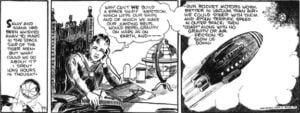By Dr. Raymond A. Keller, a.k.a. “Cosmic Ray,” author of the international awards-winning Venus Rising series of books All of Raymonds Venus Rising Books Can Be Found HERE
David B. Wittry, Ph.D., Materials Science and Electrical Engineering (1929-2007), early pioneer in anti-gravity research; for a thorough biography see http://www.davidwittry.com/.
Gravitational Screening
Back in 1949, when David B. Wittry was studying for a bachelor of science degree in applied math and mechanics at the University of Wisconsin at Madison, the burgeoning young scientist was already thinking outside the box, especially when it came to challenging and reconceptualizing our then widely held, but erroneous concepts, about the unfeasibility of building anti-gravitation devices. In his award-winning essay submitted to Roger W. Babson’s Gravity Research Foundation (GRF) of New Boston, New Hampshire, in that year, on the “Possibility of Discovering an Absorber, Insulator or Reflector for Gravity Waves,” Wittry took note that, “Serious scientists are not supposed to concern themselves with freedom from gravity. Such ideas make exciting material for pulp magazines; but anyone who seriously considers screens for gravity is immediately set off as a potential crackpot.”
Wittry did not believe that this was fair. Scientific exploration should not be restrained as there are no limits in the acquisition of knowledge. “The method of science has always been one of careful observation, generalization and mathematical expression, and then deduction and prediction,” the young scientist asserted. He added that, “A theory to be valid must be found true in subsequent experimentation and observation. But the theory must be careful not to indicate anything which is known to be absent.”
Young Wittry felt that the then extant tendency in developing theories on gravity that ignored the one effect that could not be adequately explained, gravitational screening, was quite unfortunate. Of this phenomenon, he pointed out that, “Gravitational screening is the one effect crucial in all theories of gravitation. The absence of any gravitational screening would make gravitation almost unique among physical phenomena; while the existence of it would be contrary to the myriad daily observations made consciously or unconsciously by everyone.”
Wittry saw Newton’s law as a convenient starting point in looking at the subject of gravity, especially since it has stood up over the centuries in which other physical concepts were constantly changing. The university student was concerned about the overall implications of Newton’s law, especially if they can still hold up under the light of new observations. The way that Wittry saw it, Newton’s Law of Gravitation implied that gravity was independent of the following:
- The physical condition of the mass, i.e. solid, liquid or gaseous, amorphous or crystalline.
- The chemical composition of the masses.
- The temperature of the masses or of the intervening medium.
- The directional effects.
- The nature of the intervening medium and that it acts as if were concentrated at the centroid of the masses for large distances.
Any new theory on the mechanism of gravity must take into account even the slight existence of gravitational permeability. According to Wittry, “All the theories advanced in the two centuries from Newton to Einstein have failed because they indicated gravitational permeability, and because no such effect is definitely known to exist.”
Promising areas of research were foreseen by Wittry back in 1949, however, and these included particle theories and other theories that might help to explain gravity in terms of electromagnetic fields. As Wittry saw it, particle theories made gravitation a push due to greater pressure on the far sides of two bodies than between them. Unless the matter possessed some way to stop the particles in the form of waves or rays, there could be no gravitation between them. And as to electromagnetic field theories, the presence of a screen effect is also implied insofar as it is impossible to imagine any combination of electric and magnetic fields in which one or both elements are not subject varying permeability in matter. Interestingly, these lines of research corresponded nicely with the investigations then being conducted in the British Isles by John R. R. Searl, which we covered in previous articles.
It is clear that the work being done at the GRF from the period of 1949-1953 was both keeping the subject of anti-gravity in the public’s attention as well as laying the groundwork which was pushing the subject into the realms of respectability in the scientific community. By 1954, we will start to see more involvement in this subject on the part of the United States government, with lucrative contracts being awarded to universities and corporations for the development of actual anti-gravity technology and the construction of aerospace platforms that mimicked the speeds and maneuverability of the UFOs then being sighted in ever-increasing numbers the world over.
Buck dreams of an anti-gravity rocket from the Buck Rogers 2429 A.D. comic strip by Philip Nolan and Richard Calkins. The “Tiger Men of Mars” arc appeared in the Evening Gazette of Worcester, Massachusetts in the winter of 1929.



